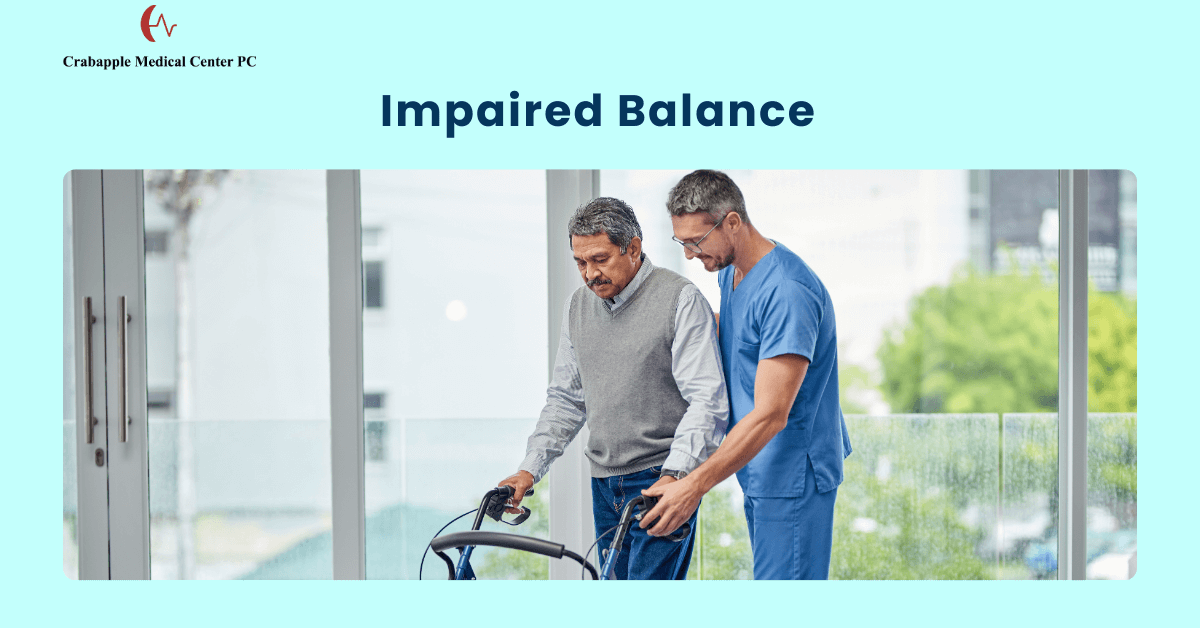As we age, maintaining mobility and balance becomes increasingly important. For seniors, one of the most common concerns is gait abnormalities, changes in the way we walk that can lead to an increased risk of falls and injuries. In fact, falls are a leading cause of injury in older adults, with an estimated 36 million falls occurring in the United States each year. The consequences of these falls can be severe, ranging from minor bruises to life-threatening fractures, particularly in seniors with weakened bones. However, the good news is that gait abnormalities can be identified and managed with the right care and proactive steps.
At Crabapple Medical Center in Alpharetta, GA, we understand the importance of fall prevention and the role that gait abnormalities play in maintaining the health and safety of our senior community. Through a comprehensive approach, we provide evaluation, treatment, and support to ensure that older adults can move with confidence, reduce the risk of falls, and enjoy an active, independent lifestyle.
In this blog, we will explore the causes of gait abnormalities in seniors, how they contribute to falls, and most importantly, how they can be prevented. We’ll discuss practical strategies, treatment options, and the role of healthcare professionals, like those at Crabapple Medical Center, in helping seniors improve their mobility and promote safety.
Understanding Gait Abnormalities in Seniors
Gait refers to the manner or pattern of walking, including the movement of the legs, feet, and posture. For seniors, gait abnormalities can be caused by a variety of factors, such as age-related changes, medical conditions, and injuries. These abnormalities may manifest as uneven steps, difficulty lifting the feet, shuffling, or an unstable walking pattern.
Some common types of gait abnormalities in seniors include:
- Shuffling gait: A slow, dragging movement of the feet, often associated with conditions like Parkinson’s disease.
- Wide-based gait: Walking with feet spread apart, typically seen in individuals with balance problems or neurological conditions.
- Steppage gait: A high stepping walk due to difficulty lifting the feet, often caused by nerve damage.
- Antalgic gait: A limp caused by pain in the joints or muscles, resulting in the individual favouring one leg over the other.
While gait abnormalities are common with aging, they can increase the risk of falling, especially when combined with other factors like muscle weakness, poor vision, and medications that affect balance.
Connection Between Gait Abnormalities and Falls in Seniors
Falls are a serious concern for seniors, and gait abnormalities are one of the leading contributors to this risk. When walking is compromised, the body’s ability to maintain balance becomes more challenging. This can lead to trips, slips, and falls, often resulting in injuries that require medical attention and lengthy recovery periods.

1. Impaired Balance
One of the most direct effects of gait abnormalities is impaired balance. For seniors with a shuffling gait or wide-based stance, the center of gravity can shift, leading to instability. Without the proper strength and coordination to adjust their posture, seniors may struggle to recover from a loss of balance, increasing the likelihood of falling.
2. Weak Muscles and Joints
Age-related muscle weakness and joint stiffness can contribute to gait abnormalities, making it harder to walk steadily. For example, seniors with arthritis may experience pain and stiffness in the joints, leading to altered walking patterns to compensate for discomfort. These adaptations can lead to missteps and falls, particularly in uneven or slippery environments.
3. Medication Side Effects
Many seniors take medications for chronic conditions like hypertension, diabetes, and arthritis. While these medications are crucial for managing health, some can have side effects that impair balance and coordination. Medications like sedatives, tranquilizers, and certain blood pressure medications may cause dizziness or drowsiness, increasing the risk of falls.
4. Visual Impairment
Poor vision is another major contributor to falls in seniors. Individuals with conditions like macular degeneration, glaucoma, or cataracts may have difficulty seeing obstacles or changes in terrain. Combined with a gait abnormality, poor vision can significantly heighten the risk of tripping or stumbling.
Preventing Falls and Promoting Safety in Seniors
While gait abnormalities can increase the risk of falls, there are numerous ways to help seniors improve their mobility, prevent falls, and stay safe. By addressing the underlying causes of gait abnormalities and promoting healthy habits, seniors can lead more independent and active lives.
1. Gait and Balance Training
One of the most effective ways to address gait abnormalities is through targeted exercise programs designed to improve strength, balance, and coordination. At Crabapple Medical Center, we offer specialized physical therapy and rehabilitation services to help seniors restore proper gait mechanics and reduce the risk of falls.
Physical therapy can focus on:
- Strengthening exercises: Building muscle strength, particularly in the lower body, helps support stability and mobility.
- Balance training: Activities like standing on one leg, heel-to-toe walking, and using balance boards can improve coordination and postural control.
- Flexibility exercises: Stretching the muscles and joints can alleviate stiffness and improve movement.
2. Corrective Footwear and Assistive Devices
Wearing proper footwear can significantly impact gait and stability. Seniors should wear shoes with non-slip soles, adequate arch support, and a firm heel to reduce the risk of falls. Avoiding high heels or slippers with a slick bottom can help maintain balance.
In some cases, assistive devices like canes, walkers, or orthotics may be necessary to provide additional support. These tools can enhance stability, help maintain proper posture, and prevent falls. At Crabapple Medical Center, our healthcare professionals assess each patient’s needs and recommend the most appropriate assistive devices.
3. Environmental Modifications
Making simple changes in the home can drastically reduce the risk of falls. Seniors with gait abnormalities should consider:
- Removing tripping hazards: Rugs, cords, and clutter should be cleared from walkways.
- Installing handrails and grab bars: Adding handrails in hallways, bathrooms, and staircases can provide extra support.
- Improving lighting: Proper lighting in hallways and stairways reduces the risk of tripping, especially for individuals with vision impairments.
At Crabapple Medical Center, we also provide guidance on making these modifications to ensure your home is a safe environment for you or your loved ones.
4. Vision Care and Regular Eye Exams
Since poor vision is a significant risk factor for falls, it is essential for seniors to have regular eye exams to detect conditions like cataracts, glaucoma, or macular degeneration. Proper corrective eyewear can help improve depth perception and ensure that seniors can see hazards before they trip. Our team at Crabapple Medical Center offers eye care referrals and comprehensive wellness exams to address vision-related concerns.
5. Managing Medications
Seniors should regularly review their medications with their healthcare provider to ensure they are not experiencing side effects that impair balance or cause dizziness. If a medication is found to be contributing to gait abnormalities, an alternative treatment plan may be considered. At Crabapple Medical Center, our doctors work closely with patients to manage medications safely and minimize any negative effects on balance or cognitive function.

Frequently Asked Questions
How can gait abnormalities lead to falls in seniors?
Gait abnormalities can cause unsteady walking, loss of balance, and missteps, which increase the likelihood of falls. Seniors with difficulty lifting their feet or those who shuffle when walking may find it harder to avoid obstacles, resulting in a higher risk of tripping or falling.
How does Crabapple Medical Center help seniors with gait abnormalities?
At Crabapple Medical Center, we provide personalized care for seniors with gait abnormalities. Our team offers physical therapy, balance training, and strength-building exercises to help improve mobility and reduce the risk of falls. We also provide recommendations for assistive devices like canes or walkers and home modifications to enhance safety.
What types of treatments are available for gait abnormalities?
Treatment for gait abnormalities often includes physical therapy to improve strength, balance, and flexibility. We also provide advice on proper footwear, assistive devices, and lifestyle changes to help improve walking and prevent falls. Our healthcare providers tailor treatment plans to everyone’s needs to ensure the best outcomes
Can home modifications help reduce the risk of falls due to gait abnormalities?
Yes, home modifications can play a crucial role in preventing falls. Simple changes like installing handrails, removing tripping hazards, improving lighting, and adding non-slip mats in bathrooms can make a significant difference.
How can physical therapy help with gait abnormalities?
Physical therapy is highly effective in improving gait and balance. It helps seniors strengthen muscles, improve coordination, and restore proper walking patterns. At Crabapple Medical Center, our physical therapists work with you to develop a customized exercise plan that focuses on improving mobility and preventing falls.
Are gait abnormalities related to any medical conditions?
Yes, gait abnormalities can be linked to several medical conditions, such as arthritis, neurological disorders (e.g., Parkinson’s disease), joint pain, muscle weakness, or even side effects from medications. If you have an underlying health condition, it’s important to work with your healthcare provider to manage it and prevent gait issues from worsening.
How do I know if I need to seek professional help for my gait abnormalities?
If you notice changes in your walking, such as unsteadiness, difficulty keeping your balance, or frequent falls, it’s important to consult with a healthcare provider. Crabapple Medical Center can assess your gait, identify potential causes, and recommend the best course of action to prevent falls and improve mobility.
How can Crabapple Medical Center improve my overall safety and mobility?
Crabapple Medical Center offers comprehensive assessments and personalized care for seniors experiencing gait abnormalities. Our team of experts works with you to improve your balance, strength, and coordination through physical therapy, lifestyle advice, assistive devices, and home safety modifications. We aim to help you stay active, independent, and safe as you age.

